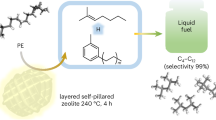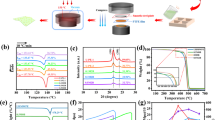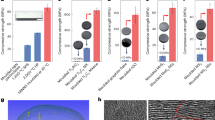Abstract
High-performance thermally insulating materials from renewable resources are needed to improve the energy efficiency of buildings. Traditional fossil-fuel-derived insulation materials such as expanded polystyrene and polyurethane have thermal conductivities that are too high for retrofitting or for building new, surface-efficient passive houses. Tailored materials such as aerogels and vacuum insulating panels are fragile and susceptible to perforation. Here, we show that freeze-casting suspensions of cellulose nanofibres, graphene oxide and sepiolite nanorods produces super-insulating, fire-retardant and strong anisotropic foams that perform better than traditional polymer-based insulating materials. The foams are ultralight, show excellent combustion resistance and exhibit a thermal conductivity of 15 mW m−1 K−1, which is about half that of expanded polystyrene. At 30 °C and 85% relative humidity, the foams retained more than half of their initial strength. Our results show that nanoscale engineering is a promising strategy for producing foams with excellent properties using cellulose and other renewable nanosized fibrous materials.
This is a preview of subscription content, access via your institution
Access options
Subscribe to this journal
Receive 12 print issues and online access
$259.00 per year
only $21.58 per issue
Buy this article
- Purchase on Springer Link
- Instant access to full article PDF
Prices may be subject to local taxes which are calculated during checkout





Similar content being viewed by others
References
International Energy Agency. Technology Roadmap: Energy Efficient Building Envelopes (2013).
Jelle, B. P. Traditional, state-of-the-art and future thermal building insulation materials and solutions—properties, requirements and possibilities. Energy Build. 43, 2549–2563 (2011).
Fernández, J. E. Materials for aesthetic, energy-efficient, and self-diagnostic buildings. Science 315, 1807–1810 (2007).
Alam, M., Singh, H. & Limbachiya, M. C. Vacuum insulation panels (VIPs) for building construction industry—a review of the contemporary developments and future directions. Appl. Energy 88, 3592–3602 (2011).
Hüsing, N. & Schubert, U. Aerogels—Airy materials: chemistry, structure, and properties. Angew. Chem. Int. Ed. 37, 22–45 (1998).
Moon, R. J., Martini, A., Nairn, J., Simonsen, J. & Youngblood, J. Cellulose nanomaterials review: structure, properties and nanocomposites. Chem. Soc. Rev. 40, 3941–3994 (2011).
Olsson, R. T. et al. Making flexible magnetic aerogels and stiff magnetic nanopaper using cellulose nanofibrils as templates. Nature Nanotech. 5, 584–588 (2010).
Hamedi, M. et al. Nanocellulose aerogels functionalized by rapid layer-by-layer assembly for high charge storage and beyond. Angew. Chem. Int. Ed. 52, 12038–12042 (2013).
Kobayashi, Y., Saito, T. & Isogai, A. Aerogels with 3D ordered nanofiber skeletons of liquid-crystalline nanocellulose derivatives as tough and transparent insulators. Angew. Chem. Int. Ed. 53, 10394–10397 (2014).
Pernot, G. et al. Precise control of thermal conductivity at the nanoscale through individual phonon-scattering barriers. Nature Mater. 9, 491–495 (2010).
Huxtable, S. T. et al. Interfacial heat flow in carbon nanotube suspensions. Nature Mater. 2, 731–734 (2003).
Losego, M. D., Blitz, I. P., Vaia, R. A., Cahill, D. G. & Braun, P. V. Ultralow thermal conductivity in organoclay nanolaminates synthesized via simple self-assembly. Nano Lett. 13, 2215–2219 (2013).
Yu, J-K., Mitrovic, S., Tham, D., Varghese, J. & Heath, J. R. Reduction of thermal conductivity in phononic nanomesh structures. Nature Nanotech. 5, 718–721 (2010).
Losego, M. D., Grady, M. E., Sottos, N. R., Cahill, D. G. & Braun, P. V. Effects of chemical bonding on heat transport across interfaces. Nature Mater. 11, 502–506 (2012).
Kashiwagi, T. et al. Nanoparticle networks reduce the flammability of polymer nanocomposites. Nature Mater. 4, 928–933 (2005).
Li, Y. et al. Flame retardant behavior of polyelectrolyte–clay thin film. ACS Nano 4, 3325–3337 (2010).
Wagner, H. D. Nanocomposites: paving the way to stronger materials. Nature Nanotech. 2, 742–744 (2007).
Lingström, R., Notley, S. M. & Wågberg, L. Wettability changes in the formation of polymeric multilayers on cellulose fibres and their influence on wet adhesion. J. Colloid Interface Sci. 314, 1–9 (2007).
Jin, C., Jiang, Y., Niu, T. & Huang, J. Cellulose-based material with amphiphobicity to inhibit bacterial adhesion by surface modification. J. Mater. Chem. 22, 12562–12567 (2012).
Deville, S., Saiz, E., Nalla, R. K. & Tomsia, A. P. Freezing as a path to build complex composites. Science 311, 515–518 (2006).
Gutiérrez, M., Ferrer, M. & del Monte, F. Templated materials: sophisticated structures exhibiting enhanced functionalities obtained after unidirectional freezing and ice-segregation-induced self-assembly. Chem. Mater. 20, 634–648 (2008).
Hong, C-Q., Han, J-C., Zhang, X-H. & Du, J-C. Novel nanoporous silica aerogel impregnated highly porous ceramics with low thermal conductivity and enhanced mechanical properties. Scr. Mater. 68, 599–602 (2013).
Ali, Z. M. & Gibson, L. J. The structure and mechanics of nanofibrillar cellulose foams. Soft Matter 9, 1580–1588 (2013).
Svagan, A. J., Samir, M. A. S. A. & Berglund, L. A. Biomimetic foams of high mechanical performance based on nanostructured cell walls reinforced by native cellulose nanofibrils. Adv. Mater. 20, 1263–1269 (2008).
Jiang, F. & Hsieh, Y-L. Super water absorbing and shape memory nanocellulose aerogels from TEMPO-oxidized cellulose nanofibrils via cyclic freezing–thawing. J. Mater. Chem. A 2, 350–359 (2014).
Lu, X., Arduini-Schuster, M., Kuhn, J. & Nilsson, O. Thermal conductivity of monolithic organic aerogels. Science 469, 1990–1991 (1992).
Kapitza, P. L. The study of heat transfer in helium II. J. Phys. 4, 181–210 (1941).
Han, Z. & Fina, A. Thermal conductivity of carbon nanotubes and their polymer nanocomposites: a review. Prog. Polym. Sci. 36, 914–944 (2011).
Glicksman, L. R. in Low Density Cellular Plastics (eds Hilyard, N. C., Cunningham, A. & Glicksman, L. R.) 104–152 (Springer, 1994).
Acik, M. et al. Unusual infrared-absorption mechanism in thermally reduced graphene oxide. Nature Mater. 9, 840–845 (2010).
Balandin, A. A. Thermal properties of graphene and nanostructured carbon materials. Nature Mater. 10, 569–581 (2011).
Antunes, M. et al. Thermal conductivity anisotropy in polypropylene foams prepared by supercritical CO2 dissolution. Mater. Chem. Phys. 136, 268–276 (2012).
Gibson, L. J. & Ashby, M. F. Cellular Solids: Structure and Properties (Cambridge Univ. Press, 1999).
Obrey, K. A. D., Wilson, K. V. & Loy, D. A. Enhancing mechanical properties of silica aerogels. J. Non-Cryst. Solids 357, 3435–3441 (2011).
An, Z., Compton, O. C., Putz, K. W., Brinson, L. C. & Nguyen, S. T. Bio-inspired borate cross-linking in ultra-stiff graphene oxide thin films. Adv. Mater. 23, 3842–3846 (2011).
Pappin, B., Kiefel, M. J. & Houston, T. A. in Carbohydrates—Comprehensive studies on Glycobiology and Glycotechnology (ed. Chang, C-F.) 37–54 (Intech, 2012).
Benítez, A., Torres-Rendon, J., Poutanen, M. & Walther, A. Humidity and multiscale structure govern mechanical properties and deformation modes in films of native cellulose nanofibrils. Biomacromolecules 14, 4497−4506 (2013).
Bénézet, J-C., Stanojlovic-Davidovic, A., Bergeret, A., Ferry, L. & Crespy, A. Mechanical and physical properties of expanded starch, reinforced by natural fibres. Ind. Crops Prod. 37, 435–440 (2012).
Dasari, A., Yu, Z-Z., Cai, G-P. & Mai, Y-W. Recent developments in the fire retardancy of polymeric materials. Prog. Polym. Sci. 38, 1357–1387 (2013).
Hale, R. C. et al. Flame retardants: persistent pollutants in land-applied sludges. Nature 412, 140–141 (2001).
Shaw, S. D. et al. Halogenated flame retardants: do the fire safety benefits justify the risks? Rev. Environ. Health 25, 261–305 (2010).
Singh, H. & Jain, A. Ignition, combustion, toxicity, and fire retardancy of polyurethane foams: a comprehensive review. J. Appl. Polym. Sci. 111, 1115–1143 (2009).
Carosio, F., Di Blasio, A., Cuttica, F., Alongi, J. & Malucelli, G. Self-assembled hybrid nanoarchitectures deposited on poly(urethane) foams capable of chemically adapting to extreme heat. RSC Adv. 4, 16674–16680 (2014).
Shi, Y. & Li, L-J. Chemically modified graphene: flame retardant or fuel for combustion? J. Mater. Chem. 21, 3277–3279 (2011).
Dreyer, D. R., Park, S., Bielawski, C. W. & Ruoff, R. S. The chemistry of graphene oxide. Chem. Soc. Rev. 39, 228–240 (2010).
Higginbotham, A. L., Lomeda, J. R., Morgan, A. B. & Tour, J. M. Graphite oxide flame-retardant polymer nanocomposites. ACS Appl. Mater. Interfaces 1, 2256–2261 (2009).
Lu, S-Y. & Hamerton, I. Recent developments in the chemistry of halogen-free flame retardant polymers. Prog. Polym. Sci. 27, 1661–1712 (2002).
Byrne, G. A., Gardiner, D. & Holmes, F. H. The pyrolysis of cellulose and the action of flame-retardants. J. Appl. Chem. 16, 81–88 (1966).
Fina, A., Bocchini, S. & Camino, G. Fire and polymers V. Am. Chem. Soc. 1013, 10–24 (2009).
Wågberg, L. et al. The build-up of polyelectrolyte multilayers of microfibrillated cellulose and cationic polyelectrolytes. Langmuir 24, 784–795 (2008).
Acknowledgements
This work was supported in part by the Swedish Strategic Foundation (SSF) (grant no. RMA11-0065), the Wallenberg Wood Science Centre (WWSC) and the Swedish Research Council (VR). L.B. acknowledges support from the Humboldt Foundation and B.W. and G.S.A. thank the Cost Action MP1202 for support. L. Wågberg is thanked for providing the nanocellulose. The authors thank, L. Berglund, J. Kochumalayil, J. Yuan, D. Kocjan and J. Lagerwall for help and valuable discussions and Z. Bacsik, A. Ojuva, J. Hornatowska, P. Fajdiga, M. Vrabelj, A. Di Blasio and F. Cuttica for various contributions.
Author information
Authors and Affiliations
Contributions
B.W., G.S.A., L.B. and M.A. conceived the study and B.W. and L.B. planned and coordinated the work. A.K. performed the thermal conductivity measurements and analysed the data together with B.W. B.W. carried out and analysed the mechanical strength data. B.W., F.C. and G.C. carried out and analysed the flame retardancy measurements. B.W., G.S.A. and L.B. wrote the manuscript.
Corresponding author
Ethics declarations
Competing interests
The authors declare no competing financial interests.
Supplementary information
Supplementary information
Supplementary Information (PDF 1476 kb)
Supplementary Movie 1
Supplementary Movie 1 (MOV 864 kb)
Supplementary Movie 2
Supplementary Movie 2 (MOV 813 kb)
Supplementary Movie 3
Supplementary Movie 3 (MOV 540 kb)
Supplementary Movie 4
Supplementary Movie 4 (MOV 668 kb)
Rights and permissions
About this article
Cite this article
Wicklein, B., Kocjan, A., Salazar-Alvarez, G. et al. Thermally insulating and fire-retardant lightweight anisotropic foams based on nanocellulose and graphene oxide. Nature Nanotech 10, 277–283 (2015). https://doi.org/10.1038/nnano.2014.248
Received:
Accepted:
Published:
Issue Date:
DOI: https://doi.org/10.1038/nnano.2014.248
This article is cited by
-
Highly Porous Yet Transparent Mechanically Flexible Aerogels Realizing Solar-Thermal Regulatory Cooling
Nano-Micro Letters (2024)
-
Flame-retardant, cellulose-based, thermal insulating polyHIPEs and their application for early fire warning
Cellulose (2024)
-
Recent Progress of Bionic Hierarchical Structure in the Field of Thermal Insulation Protection
Journal of Bionic Engineering (2024)
-
Large-scale assembly of isotropic nanofiber aerogels based on columnar-equiaxed crystal transition
Nature Communications (2023)
-
Multi-layered cement-hydrogel composite with high toughness, low thermal conductivity, and self-healing capability
Nature Communications (2023)



